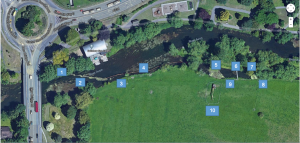The latest news is that the EA held a meeting with several members of their Ops teams, including the likes of Jim Wreglesworth, Bruce Thorne and David Merrick – who have many years’ experience installing booms, and many other in-channel works, where they discussed at length the issues for the team associated with working in close proximity.
Whilst most parts of the boom installation process are possible by social distancing, and through hygiene/cleaning measures, it appears they are still unable to come up with a suitable work-around for the process of actually securing the boom (usually achieved by driving long scaffold bars into the river bed), or indeed securing the boom poles themselves into position (which is necessary to keep the boom pins orientated into the correctly elevated position).
The bottom line is the EA requires four members of staff to be in the same boat to complete these tasks, and under current guidance they are not happy they can meet the necessary Health, Safety and Wellbeing standards to manage that risk. Additionally, as part of a government department, we must be mindful that the EA are following the same strict guidance which all other businesses and members of the community, including us, are being asked to adhere to.
As you will have already gleaned from the above, this leaves us in an unchanged situation from where we were at the start of the C-19 working restrictions in that, if the EA are unable to install the booms we cannot cut weed unless we self-extract it ourselves.
If you have any questions, please do not hesitate to get in touch.
Bob Wellard – Hon Sec
M: 07872583910
E: wfa.honsec@btinternet.com
EA Weed Booms – Salisbury
1 = Permanent concrete ground anchor with associated fixing chain (inspected and certificated annually before use by AM Defence & Marine).
2 = ‘Main Boom’ which prevents weed from going straight on down the main river, and encourages surface velocities to guide the floating cut weed towards the ‘Deflector Boom’ (see 4).
3 = Permanent concrete ground anchor with associated fixing chain (inspected and certificated annually before use by AM Defence & Marine).
4 = ‘Deflector Boom’, a floating boom with a hanging ‘skirt’ beneath the surface, this boom guides the floating cut weed into the mouth of the Navigation Carrier.
5 = First ‘Catching Boom’, which is where the cut weed is actually stopped and allowed to build up until there is enough to warrant removal from site.
6 = Footbridge (owned and maintained by London Anglers’ Association).
7 = Second ‘Catching Boom’, which acts as a second line of defence to catch any weed which manages to sneak under the first catching boom…’belt and braces’.
8 = Permanent concrete ground anchor with associated fixing chain (inspected and certificated annually before use by AM Defence & Marine).
9 = Permanent concrete ground anchor with associated fixing chain (inspected and certificated annually before use by AM Defence & Marine).
10 = Long-reach excavator within fenced area.
Note: All booms are held in place using Tirfor winches (rated 3.2t for the Main Boom and Catching Booms, and 1.6t for the Deflector Boom – all inspected annually and certificated by AM Defence & Marine).

